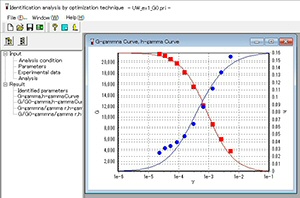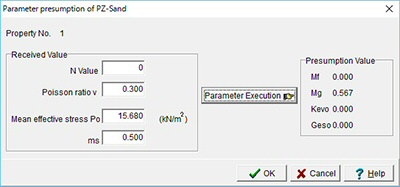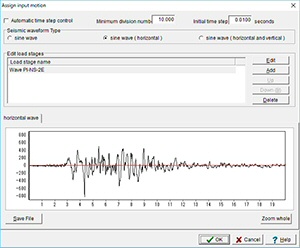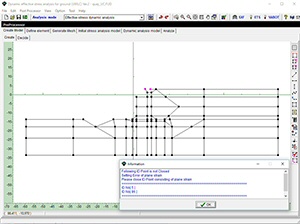Sand and clay have the strain dependence as the coseismic dynamic deformation characteristic. As the shear strain gamma increases, the shear rigidity G decreases and the hysteretic damping h increases. Whether it is a total stress method or an effective stress method, in the condition of the repeating load like an earthquake as a soil dynamic deformation feature, the shear rigidity decreases gradually according to the increase of the shear strain, and the damping which means energy consumption rises. In the interior test like a vibration triaxial test and a hollow torsion test, the alternate load is applied repeatedly to measure the soil shear strain and the result is shown as G-to-gamma curve. This time, identification analysis program (Fig. 1) by the optimization method has been added to UWLC. This function decides the best parameter for the soil structure model by the value of G and gamma obtained by the interior test. Available soil structure models are RO (Ramberg-Osgood), HD (Hardin-Drnevich), and UW (Ugai-Wakai)-Clay.
This identification analysis program can be used as an attached program independently from the main body. The best parameter obtained by this program is able to be read in the material property setting by UWLC main unit. As to the soil structure model UW-Clay, it is possible to read the determined parameter from the conventional element test simulation program and to simulate the stress strain curve.
Estimate the sand structure model parameter from N value
The precise modelization of phenomena at the time of the earthquake, the detailed input data, and the advanced and technical judgement are required generally In order to estimate sand structure model parameters.
In particular, with regard to the soil structure model of the sand which has a possibility of liquefaction, the function to estimate parameter from N value of the standard penetration test has been added in this version. This function is to estimate the angle of the internal friction and the deformation coefficient from N value and then to estimate parameter used for the sand structure model. The existing attached element test simulation helps you to check up the model in detail.
As a soil model for liquefaction, elasto-plasticity and PZ-Sand (Pastor-Zienkiewicz) are available in UWLC. Until now, it was necessary to obtain the angle of the internal friction and the deformation coefficient and to calculate the parameter to define the alternation line in advance in order to determine the parameter. Alteration line defines shift in constriction and swelling of sand dilatancy in the stress space. Sand constricts if Mohr's stress circle is within the alteration line, and if not, it swells. Parameters can be estimated from N-value with this function now. (Fig.2)
 |
 Fig. 1 Identification analysis by the optimization method Fig. 1 Identification analysis by the optimization method |
 |
 Fig.2 Parameter estimation of PZ-Sand Fig.2 Parameter estimation of PZ-Sand |
Coinstantaneous vibration in vertical direction and horizontal direction
From this version, seismic shaking in both direction of vertical and horizontal can be entered at the same time. (Fig.3)
 |
 Fig.3 Seismic wave form setting Fig.3 Seismic wave form setting |
Model generation function
In addition to the check function for the closing and the neighborhood node, various commands have been strengthened with consideration for the operability improvement.
 |
 Fig.4 Closing check Fig.4 Closing check |

